[English] 日本語
 Yorodumi
Yorodumi- PDB-1f3v: Crystal structure of the complex between the N-terminal domain of... -
+ Open data
Open data
- Basic information
Basic information
| Entry | Database: PDB / ID: 1f3v | ||||||
|---|---|---|---|---|---|---|---|
| Title | Crystal structure of the complex between the N-terminal domain of TRADD and the TRAF domain of TRAF2 | ||||||
 Components Components |
| ||||||
 Keywords Keywords | APOPTOSIS / a-b sandwich | ||||||
| Function / homology |  Function and homology information Function and homology informationTORC2 complex disassembly / CD40 receptor binding / TORC1 complex assembly / tumor necrosis factor receptor superfamily complex / death domain binding / sphingolipid binding / TRAF2-GSTP1 complex / IRE1-TRAF2-ASK1 complex / CD27 signaling pathway / positive regulation of hair follicle development ...TORC2 complex disassembly / CD40 receptor binding / TORC1 complex assembly / tumor necrosis factor receptor superfamily complex / death domain binding / sphingolipid binding / TRAF2-GSTP1 complex / IRE1-TRAF2-ASK1 complex / CD27 signaling pathway / positive regulation of hair follicle development / Defective RIPK1-mediated regulated necrosis / TNF receptor superfamily (TNFSF) members mediating non-canonical NF-kB pathway / CD40 signaling pathway / tumor necrosis factor binding / TRAIL-activated apoptotic signaling pathway / Regulation by c-FLIP / CASP8 activity is inhibited / Dimerization of procaspase-8 / interleukin-17-mediated signaling pathway / negative regulation of glial cell apoptotic process / TNF signaling / CD40 receptor complex / programmed necrotic cell death / Caspase activation via Death Receptors in the presence of ligand / death-inducing signaling complex / transmembrane receptor protein tyrosine kinase adaptor activity / thioesterase binding / positive regulation of tumor necrosis factor-mediated signaling pathway / tumor necrosis factor receptor binding / mRNA stabilization / regulation of immunoglobulin production / non-canonical NF-kappaB signal transduction / vesicle membrane / regulation of JNK cascade / positive regulation of extrinsic apoptotic signaling pathway / mitogen-activated protein kinase kinase kinase binding / signal transduction involved in regulation of gene expression / TNFR1-induced proapoptotic signaling / TRAF6 mediated IRF7 activation / RIPK1-mediated regulated necrosis / positive regulation of JUN kinase activity / TRAF6 mediated NF-kB activation / intrinsic apoptotic signaling pathway in response to endoplasmic reticulum stress / extrinsic apoptotic signaling pathway via death domain receptors / protein K63-linked ubiquitination / canonical NF-kappaB signal transduction / ubiquitin ligase complex / regulation of protein-containing complex assembly / protein autoubiquitination / extrinsic apoptotic signaling pathway / signaling adaptor activity / positive regulation of interleukin-2 production / cellular response to nitric oxide / response to endoplasmic reticulum stress / T cell activation / tumor necrosis factor-mediated signaling pathway / TNFR1-induced NF-kappa-B signaling pathway / Regulation of NF-kappa B signaling / TNFR2 non-canonical NF-kB pathway / Regulation of TNFR1 signaling / protein catabolic process / positive regulation of NF-kappaB transcription factor activity / positive regulation of T cell cytokine production / RING-type E3 ubiquitin transferase / Regulation of necroptotic cell death / kinase binding / cytoplasmic side of plasma membrane / positive regulation of inflammatory response / ubiquitin-protein transferase activity / cellular response to tumor necrosis factor / ubiquitin protein ligase activity / protein-containing complex assembly / cell cortex / protein phosphatase binding / protein-macromolecule adaptor activity / regulation of apoptotic process / cytoskeleton / positive regulation of canonical NF-kappaB signal transduction / receptor complex / Ub-specific processing proteases / positive regulation of cell migration / positive regulation of apoptotic process / membrane raft / innate immune response / apoptotic process / ubiquitin protein ligase binding / protein kinase binding / protein-containing complex binding / enzyme binding / signal transduction / zinc ion binding / nucleoplasm / identical protein binding / nucleus / plasma membrane / cytoplasm / cytosol Similarity search - Function | ||||||
| Biological species |  Homo sapiens (human) Homo sapiens (human) | ||||||
| Method |  X-RAY DIFFRACTION / X-RAY DIFFRACTION /  SYNCHROTRON / Resolution: 2 Å SYNCHROTRON / Resolution: 2 Å | ||||||
 Authors Authors | Park, Y.C. / Ye, H. / Hsia, C. / Segal, D. / Rich, R. / Liou, H.-C. / Myszka, D. / Wu, H. | ||||||
 Citation Citation |  Journal: Cell(Cambridge,Mass.) / Year: 2000 Journal: Cell(Cambridge,Mass.) / Year: 2000Title: A novel mechanism of TRAF signaling revealed by structural and functional analyses of the TRADD-TRAF2 interaction. Authors: Park, Y.C. / Ye, H. / Hsia, C. / Segal, D. / Rich, R.L. / Liou, H.C. / Myszka, D.G. / Wu, H. | ||||||
| History |
|
- Structure visualization
Structure visualization
| Structure viewer | Molecule:  Molmil Molmil Jmol/JSmol Jmol/JSmol |
|---|
- Downloads & links
Downloads & links
- Download
Download
| PDBx/mmCIF format |  1f3v.cif.gz 1f3v.cif.gz | 82.2 KB | Display |  PDBx/mmCIF format PDBx/mmCIF format |
|---|---|---|---|---|
| PDB format |  pdb1f3v.ent.gz pdb1f3v.ent.gz | 61.4 KB | Display |  PDB format PDB format |
| PDBx/mmJSON format |  1f3v.json.gz 1f3v.json.gz | Tree view |  PDBx/mmJSON format PDBx/mmJSON format | |
| Others |  Other downloads Other downloads |
-Validation report
| Summary document |  1f3v_validation.pdf.gz 1f3v_validation.pdf.gz | 373.3 KB | Display |  wwPDB validaton report wwPDB validaton report |
|---|---|---|---|---|
| Full document |  1f3v_full_validation.pdf.gz 1f3v_full_validation.pdf.gz | 381.5 KB | Display | |
| Data in XML |  1f3v_validation.xml.gz 1f3v_validation.xml.gz | 9.1 KB | Display | |
| Data in CIF |  1f3v_validation.cif.gz 1f3v_validation.cif.gz | 14.4 KB | Display | |
| Arichive directory |  https://data.pdbj.org/pub/pdb/validation_reports/f3/1f3v https://data.pdbj.org/pub/pdb/validation_reports/f3/1f3v ftp://data.pdbj.org/pub/pdb/validation_reports/f3/1f3v ftp://data.pdbj.org/pub/pdb/validation_reports/f3/1f3v | HTTPS FTP |
-Related structure data
| Similar structure data |
|---|
- Links
Links
- Assembly
Assembly
| Deposited unit | 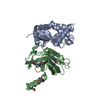
| ||||||||
|---|---|---|---|---|---|---|---|---|---|
| 1 |
| ||||||||
| Unit cell |
|
- Components
Components
| #1: Protein | Mass: 19412.998 Da / Num. of mol.: 1 / Fragment: N-TERMINAL DOMAIN Source method: isolated from a genetically manipulated source Source: (gene. exp.)  Homo sapiens (human) / Plasmid: PET / Production host: Homo sapiens (human) / Plasmid: PET / Production host:  |
|---|---|
| #2: Protein | Mass: 19718.646 Da / Num. of mol.: 1 / Fragment: TRAF DOMAIN Source method: isolated from a genetically manipulated source Source: (gene. exp.)  Homo sapiens (human) / Plasmid: PET / Production host: Homo sapiens (human) / Plasmid: PET / Production host:  |
| #3: Water | ChemComp-HOH / |
| Has protein modification | Y |
-Experimental details
-Experiment
| Experiment | Method:  X-RAY DIFFRACTION / Number of used crystals: 1 X-RAY DIFFRACTION / Number of used crystals: 1 |
|---|
- Sample preparation
Sample preparation
| Crystal | Density Matthews: 2.71 Å3/Da / Density % sol: 54.56 % | |||||||||||||||
|---|---|---|---|---|---|---|---|---|---|---|---|---|---|---|---|---|
| Crystal grow | Temperature: 293 K / Method: vapor diffusion / Details: VAPOR DIFFUSION, temperature 293K | |||||||||||||||
| Crystal grow | *PLUS pH: 5.6 | |||||||||||||||
| Components of the solutions | *PLUS
|
-Data collection
| Diffraction | Mean temperature: 100 K |
|---|---|
| Diffraction source | Source:  SYNCHROTRON / Site: SYNCHROTRON / Site:  NSLS NSLS  / Beamline: X4A / Wavelength: 0.9 / Beamline: X4A / Wavelength: 0.9 |
| Detector | Type: ADSC / Detector: CCD / Date: Jun 1, 1999 |
| Radiation | Protocol: SINGLE WAVELENGTH / Monochromatic (M) / Laue (L): M / Scattering type: x-ray |
| Radiation wavelength | Wavelength: 0.9 Å / Relative weight: 1 |
| Reflection | Resolution: 2→20 Å |
| Reflection | *PLUS % possible obs: 96.9 % / Rmerge(I) obs: 0.036 |
- Processing
Processing
| Software |
| ||||||||||||
|---|---|---|---|---|---|---|---|---|---|---|---|---|---|
| Refinement | Resolution: 2→20 Å / σ(F): 2 /
| ||||||||||||
| Refinement step | Cycle: LAST / Resolution: 2→20 Å
| ||||||||||||
| Software | *PLUS Name: CNS / Classification: refinement | ||||||||||||
| Refinement | *PLUS Highest resolution: 2 Å / Lowest resolution: 20 Å / σ(F): 2 / Rfactor obs: 0.229 | ||||||||||||
| Solvent computation | *PLUS | ||||||||||||
| Displacement parameters | *PLUS | ||||||||||||
| Refine LS restraints | *PLUS
|
 Movie
Movie Controller
Controller


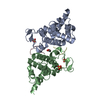
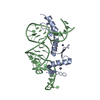
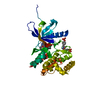
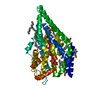
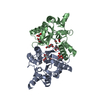
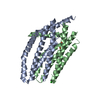

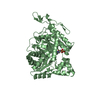

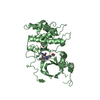
 PDBj
PDBj














